Lab alumni
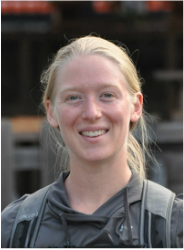
Alison Ravenscraft, PERT Postdoctoral Fellow. Finished April 2019, starting Assistant Professor (Sept. 2019) at the University of Texas, Arlington.
The overarching goal of my research is to better understand the ecological and evolutionary relationships between insects and their symbiotic microbial communities. For my dissertation research I studied the gut flora of adult butterflies, asking how host feeding guild affects gut community composition and, in turn, how the gut flora alter host fitness. The gut microbial community is fantastically complex, which makes it fascinating but difficult to manipulate. For my current postdoctoral research I am therefore employing a simplified system – a stilt bug, Jalysus wickhami, and the Burkholderia bacteria housed in its gut crypts – to ask if environmental symbiont acquisition can provide instantaneous “adaptations” to the specific conditions of a host’s local environment, such as local climate, host plants, and pathogens. [email protected]
The overarching goal of my research is to better understand the ecological and evolutionary relationships between insects and their symbiotic microbial communities. For my dissertation research I studied the gut flora of adult butterflies, asking how host feeding guild affects gut community composition and, in turn, how the gut flora alter host fitness. The gut microbial community is fantastically complex, which makes it fascinating but difficult to manipulate. For my current postdoctoral research I am therefore employing a simplified system – a stilt bug, Jalysus wickhami, and the Burkholderia bacteria housed in its gut crypts – to ask if environmental symbiont acquisition can provide instantaneous “adaptations” to the specific conditions of a host’s local environment, such as local climate, host plants, and pathogens. [email protected]
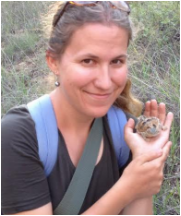
Alison Bockoven, PERT Postdoctoral Fellow. Finished August 2018, now Faculty, Arizona Western College.
I am an insect ecologist broadly interested in the causes and consequences of intraspecific variation. In my dissertation research, I investigated genetic and environmental factors affecting colony-level differences in fire ant foraging behavior and activity. In my current postdoctoral project in the Hunter lab, I am studying variation in the effects and distribution of the endosymbiont Rickettsia in populations of its whitefly host. By exploring how host nuclear background, population structure, and plant-herbivore interactions affect the conditional fitness benefits of this widespread endosymbiont, I hope to generate a more comprehensive picture of the web of factors that create the dynamic interactions between hosts and symbionts in nature. [email protected]
I am an insect ecologist broadly interested in the causes and consequences of intraspecific variation. In my dissertation research, I investigated genetic and environmental factors affecting colony-level differences in fire ant foraging behavior and activity. In my current postdoctoral project in the Hunter lab, I am studying variation in the effects and distribution of the endosymbiont Rickettsia in populations of its whitefly host. By exploring how host nuclear background, population structure, and plant-herbivore interactions affect the conditional fitness benefits of this widespread endosymbiont, I hope to generate a more comprehensive picture of the web of factors that create the dynamic interactions between hosts and symbionts in nature. [email protected]
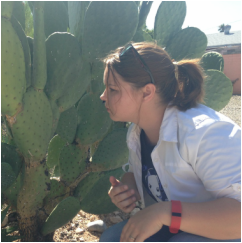
Jessica Vogt, PhD Student, withdrew to move back to Wyoming. Now a Wildlife Biologist (since Nov. 2018).
I earned my BS in Zoology and my MSc in Zoology at the University of Wyoming. I looked at tracheal investment in bumble bees (Bombus impatiens) as a possible indicator of oxygen limitation driving limitations in insect body size. I then worked as a research technician at the University of Idaho Kimberly Extension, where I worked on monitoring the occurrence of potato psyllids and their bacterial symbiont in local potato crops. I am currently working with cochineal, Dactylopius spp., on different varieties of prickly pear in Tucson. I am interested in potential host shifts in Dactylopius, and the role that their symbionts may play in these shifts. [email protected]
I earned my BS in Zoology and my MSc in Zoology at the University of Wyoming. I looked at tracheal investment in bumble bees (Bombus impatiens) as a possible indicator of oxygen limitation driving limitations in insect body size. I then worked as a research technician at the University of Idaho Kimberly Extension, where I worked on monitoring the occurrence of potato psyllids and their bacterial symbiont in local potato crops. I am currently working with cochineal, Dactylopius spp., on different varieties of prickly pear in Tucson. I am interested in potential host shifts in Dactylopius, and the role that their symbionts may play in these shifts. [email protected]
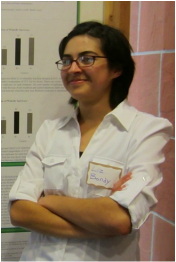
Liz Bondy, MS student, defended April 2018, then a Research Scientist at Biospyder, Oceanside, CA (since April 2018), now an Associate Agricultural weights/Measures inspector in the Bureau of IPM, Los Angeles County, working on invasive insects (since June 2019).
I finished UA with a BS in Ecology and Evolutionary Biology (Dec. 2012). As a UBRP (Undergraduate Biology Research Program) student I worked with PhD student Bodil Cass on the influence of Rickettsia on heat shock in whiteflies, and then went overseas to Dr. Jeremy Brownlie's laboratory at Griffith University in Brisbane, Australia for six months with the BRAVO (Biomedical Research Abroad: Vistas Open!) program where I studied the role of Wolbachia infection on Drosophila behavior. In the Hunter laboratory, now, I am assisting on projects on Rickettsia in whiteflies and also starting some of my own. Recently, I've been developing cytological techniques to determine egg fertilization rates in Rickettsia-infected and uninfected whiteflies, testing the hypothesis that the female bias observed in Rickettsia-infected whiteflies is due to greater fertilization rates. (Because whiteflies are haplodiploid, fertilized eggs are incipient females. ) [email protected]
I finished UA with a BS in Ecology and Evolutionary Biology (Dec. 2012). As a UBRP (Undergraduate Biology Research Program) student I worked with PhD student Bodil Cass on the influence of Rickettsia on heat shock in whiteflies, and then went overseas to Dr. Jeremy Brownlie's laboratory at Griffith University in Brisbane, Australia for six months with the BRAVO (Biomedical Research Abroad: Vistas Open!) program where I studied the role of Wolbachia infection on Drosophila behavior. In the Hunter laboratory, now, I am assisting on projects on Rickettsia in whiteflies and also starting some of my own. Recently, I've been developing cytological techniques to determine egg fertilization rates in Rickettsia-infected and uninfected whiteflies, testing the hypothesis that the female bias observed in Rickettsia-infected whiteflies is due to greater fertilization rates. (Because whiteflies are haplodiploid, fertilized eggs are incipient females. ) [email protected]
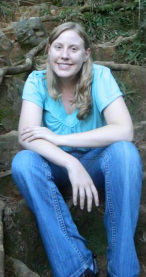
Dr. Corinne Stouthamer, PhD Student, then was the Laboratory Manager of the Todd Schlenke laboratory, the University of Arizona (since Oct. 2017), now the new Laboratory Manager of the Gaelen Burke laboratory at the University of Georgia (since August 2021).
I am generally interested in the role of endosymbionts in the biology of their arthropod hosts. The fitness of maternally inherited endosymbionts is closely associated with the daughter production of their hosts. In my dissertation research, I am investigating how one lineage of endosymbiotic bacteria, Cardinium, has evolved, by developing genetic tools to sort out relatedness between strains. In addition I am interested in how, on the genetic level, Cardinium induces a reproductive manipulation, called cytoplasmic incompatibility. Thirdly, I am interested in the potential benefits one host, Encarsia pergandiella, may gain by harboring Cardinium. [email protected]
I am generally interested in the role of endosymbionts in the biology of their arthropod hosts. The fitness of maternally inherited endosymbionts is closely associated with the daughter production of their hosts. In my dissertation research, I am investigating how one lineage of endosymbiotic bacteria, Cardinium, has evolved, by developing genetic tools to sort out relatedness between strains. In addition I am interested in how, on the genetic level, Cardinium induces a reproductive manipulation, called cytoplasmic incompatibility. Thirdly, I am interested in the potential benefits one host, Encarsia pergandiella, may gain by harboring Cardinium. [email protected]
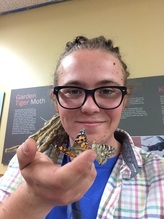
Jimmy Conway, MS Student, defended Sept. 2017, currently a teacher of exceptional education at Palo Verde High School (since Fall 2018).
A B.S. in conservation biology, earned at the University of Arizona, strongly influenced my desire to protect biological systems and increase biodiversity. My interests include, fungal, bacterial, viral, and other microbial symbionts, and biological control, with a special fascination for parasites and parasitoids. Lastly, I am an aspiring science communicator and macro photographer, tweeting from the handle @InsectophileJim [email protected]
A B.S. in conservation biology, earned at the University of Arizona, strongly influenced my desire to protect biological systems and increase biodiversity. My interests include, fungal, bacterial, viral, and other microbial symbionts, and biological control, with a special fascination for parasites and parasitoids. Lastly, I am an aspiring science communicator and macro photographer, tweeting from the handle @InsectophileJim [email protected]
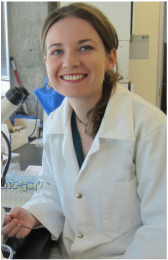
Dr. Bodil Cass, defended PhD in 2015, currently a postdoc at UC Davis in Dr. Jay Rosenheim's laboratory (since Jan. 2016).
I am interested in the role that microbial symbionts can play in allowing their host insects, especially pest species, to adapt to new environments. My current research explores the interaction between the sweetpotato whitefly, Bemisia tabaci, and a Rickettsia bacterium that recently swept through southwestern USA B. tabaci populations. I am using an interdisciplinary approach with field, laboratory and genomic tools to investigate the mechanisms and consequences of this new symbiosis.
I am interested in the role that microbial symbionts can play in allowing their host insects, especially pest species, to adapt to new environments. My current research explores the interaction between the sweetpotato whitefly, Bemisia tabaci, and a Rickettsia bacterium that recently swept through southwestern USA B. tabaci populations. I am using an interdisciplinary approach with field, laboratory and genomic tools to investigate the mechanisms and consequences of this new symbiosis.
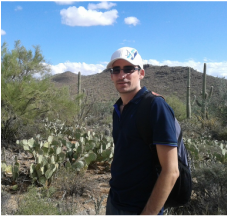
Marco Gebiola, Marie Curie Postdoctoral Fellow, Currently a postdoc at UC Riverside (since 2016).
I am interested in the taxonomy, systematics and population genetics of Chalcidoidea, with a focus on exploring different types of data and ways to integrate them in an Integrative Taxonomy approach. I am also interested in invasive species and their parasitoids, in particular in the phylogeography of pests and parasitoids and in investigating patterns of adaptation of native parasitoids. Recently, I learned Restriction-site associated DNA sequencing (RADseq) for non-model organisms. In the Hunter laboratory I am involved in two projects: In one, I am studying the nuclear and symbiotic contributions to hybrid inviability in two closely related parasitoids. In another, I am looking at the events in early embryogenesis of an egg affected by cytoplasmic incompatibility Cardinium.
I am interested in the taxonomy, systematics and population genetics of Chalcidoidea, with a focus on exploring different types of data and ways to integrate them in an Integrative Taxonomy approach. I am also interested in invasive species and their parasitoids, in particular in the phylogeography of pests and parasitoids and in investigating patterns of adaptation of native parasitoids. Recently, I learned Restriction-site associated DNA sequencing (RADseq) for non-model organisms. In the Hunter laboratory I am involved in two projects: In one, I am studying the nuclear and symbiotic contributions to hybrid inviability in two closely related parasitoids. In another, I am looking at the events in early embryogenesis of an egg affected by cytoplasmic incompatibility Cardinium.
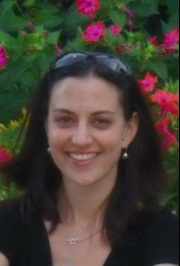
Dr. Anna Himler, Postdoctoral Associate, Now Assistant Professor, College of Idaho (since Fall 2014)
I am a broadly trained evolutionary ecologist who studies insect-symbiont interactions in two research systems, leaf cutting ants and the fungi they cultivate, and whiteflies and their intracellular bacterial symbionts. Within these two insect systems I address questions relating to 1) host-microbe evolution and ecology, 2) speciation by host switching, and 3) the evolution of asexuality. During my doctoral work with fungus-growing ants at the University of Texas at Austin with Ulrich Mueller, I studied the ecology and evolution of host switching and speciation by examining the fidelity between ant species and their associated fungi, and the evolution of asexuality in fungus-growing ants. I combined extensive field collections with behavior experiments in the lab, and used several genetic methods such as sequencing, microsatellite, and AFLP approaches for phylogenetic analyses to study population structure and co-phylogeny. In my current work in the Hunter laboratory, I studied the dynamic interaction and ecological impact of the bacterial symbiont Rickettsia in invasive whiteflies. This includes studying performance effects of Rickettsia infection in different whitefly genetic backgrounds, the effects of symbiont infection on whitefly flight, and the mechanistic aspects of how the symbiont influences whitefly performance, such as microbial manipulation of plant defenses.
I am a broadly trained evolutionary ecologist who studies insect-symbiont interactions in two research systems, leaf cutting ants and the fungi they cultivate, and whiteflies and their intracellular bacterial symbionts. Within these two insect systems I address questions relating to 1) host-microbe evolution and ecology, 2) speciation by host switching, and 3) the evolution of asexuality. During my doctoral work with fungus-growing ants at the University of Texas at Austin with Ulrich Mueller, I studied the ecology and evolution of host switching and speciation by examining the fidelity between ant species and their associated fungi, and the evolution of asexuality in fungus-growing ants. I combined extensive field collections with behavior experiments in the lab, and used several genetic methods such as sequencing, microsatellite, and AFLP approaches for phylogenetic analyses to study population structure and co-phylogeny. In my current work in the Hunter laboratory, I studied the dynamic interaction and ecological impact of the bacterial symbiont Rickettsia in invasive whiteflies. This includes studying performance effects of Rickettsia infection in different whitefly genetic backgrounds, the effects of symbiont infection on whitefly flight, and the mechanistic aspects of how the symbiont influences whitefly performance, such as microbial manipulation of plant defenses.
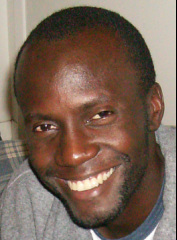
Dr. Peter Asiimwe, Postdoctoral Associate, Now Research Scientist, Monsanto Corporation (since Summer 2013)
I am interested in the ecology of agricultural insect pests. In my Masters research in my home country Uganda, I investigated the potential for using natural enemies in the management of whiteflies on cassava. I identified parasitism as the key mortality factor of whiteflies in the field. During my dissertation studies at the University of Arizona with Peter Ellsworth and Steve Naranjo, I looked at the relative influence of top-down (natural enemies) and bottom-up (plant quality as influenced by irrigation) effects on the seasonal dynamics of Bemisia tabaci and Lygus hesperus in cotton. Using life tables and other measures of insect demography, I found that natural enemy effects, through predation, far outweigh plant quality effects on whitefly and Lygus populations. In the Hunter laboratory, I studied the effect of Rickettsia on whitefly performance on cotton in the field, and found that Rickettsia-infected whiteflies greatly out-performed uninfected whiteflies, consistent with the Rickettsia sweep in whiteflies and the laboratory performance results. I am now a Research Entomologist at Monsanto in St. Louis, MO, involved in environment interaction studies of Biotech crops.
I am interested in the ecology of agricultural insect pests. In my Masters research in my home country Uganda, I investigated the potential for using natural enemies in the management of whiteflies on cassava. I identified parasitism as the key mortality factor of whiteflies in the field. During my dissertation studies at the University of Arizona with Peter Ellsworth and Steve Naranjo, I looked at the relative influence of top-down (natural enemies) and bottom-up (plant quality as influenced by irrigation) effects on the seasonal dynamics of Bemisia tabaci and Lygus hesperus in cotton. Using life tables and other measures of insect demography, I found that natural enemy effects, through predation, far outweigh plant quality effects on whitefly and Lygus populations. In the Hunter laboratory, I studied the effect of Rickettsia on whitefly performance on cotton in the field, and found that Rickettsia-infected whiteflies greatly out-performed uninfected whiteflies, consistent with the Rickettsia sweep in whiteflies and the laboratory performance results. I am now a Research Entomologist at Monsanto in St. Louis, MO, involved in environment interaction studies of Biotech crops.
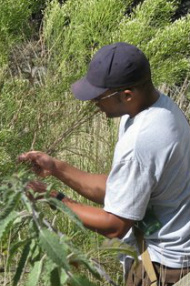
Dr. Joe Deas, Jr., PhD Student, Now Postdoctoral Associate, Harvard University (Extavour laboratory, Sept. 2015; First postdoc University of Kentucky 2013-2015)
Animal parents exhibit various behaviors that increase the survival of their offspring. In my dissertation research, I studied different aspects of a novel behavior in which females of a seed beetle species (Mimosestes amicus) use eggs as protective coverings for other eggs, shielding them from a parasitic wasp species (Uscana semifumipennis). My general interests are in the evolution, physiology, and variety of behaviors represented in reproductive plasticity, using seed beetles (Chrysomelidae: Bruchinae) as a model system. In my postdoctoral research at the University of Kentucky, I am working with Chuck Fox on egg-size plasticity in Stator limbatus, specifically on the mechanistic basis for maternal influence on offspring survival across various host plants.
Animal parents exhibit various behaviors that increase the survival of their offspring. In my dissertation research, I studied different aspects of a novel behavior in which females of a seed beetle species (Mimosestes amicus) use eggs as protective coverings for other eggs, shielding them from a parasitic wasp species (Uscana semifumipennis). My general interests are in the evolution, physiology, and variety of behaviors represented in reproductive plasticity, using seed beetles (Chrysomelidae: Bruchinae) as a model system. In my postdoctoral research at the University of Kentucky, I am working with Chuck Fox on egg-size plasticity in Stator limbatus, specifically on the mechanistic basis for maternal influence on offspring survival across various host plants.
Other senior lab alumni (excluding undergraduates, and in approximate receding order): Cara Gibson (MS, PhD, postdoc, now Assistant Professor of Practice, UA Dept. of Entomology ), Steve Perlman (Postdoc, now Professor, University of Victoria, BC, Canada), Jen White (Postdoc, now Associate Professor, University of Kentucky), Kerry Oliver (PhD, Postdoc, now Associate Professor, University of Georgia), Sarah Kenyon (MS), Dave Donnell (PhD, now Associate Professor, The Citadel), Tim Collier (Postdoc, now Associate Professor, University of Wyoming), DeWayne Shoemaker (Postdoc, now Department Head, University of Tennessee, Dept. of Entomology & Plant Pathology), Mette Petersen (Postdoc), Melinda McElveen (now Byrns; MS, now Medical Research Librarian, Inova Fairfax Hospital ), Albert Owen (MS), Jessa Netting (MS, Science writer, now Managing Editor, Medscape Consult at WebMD).




